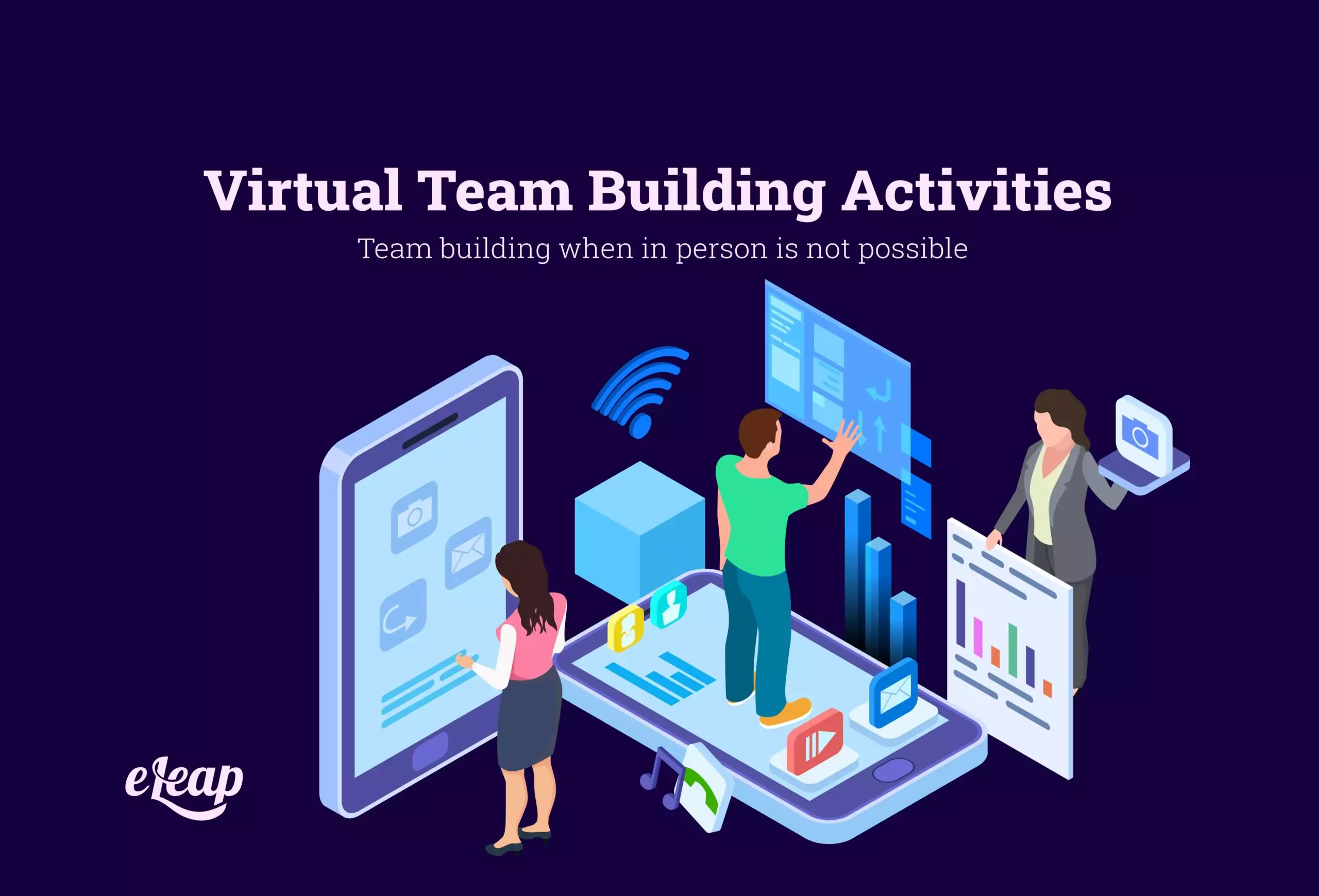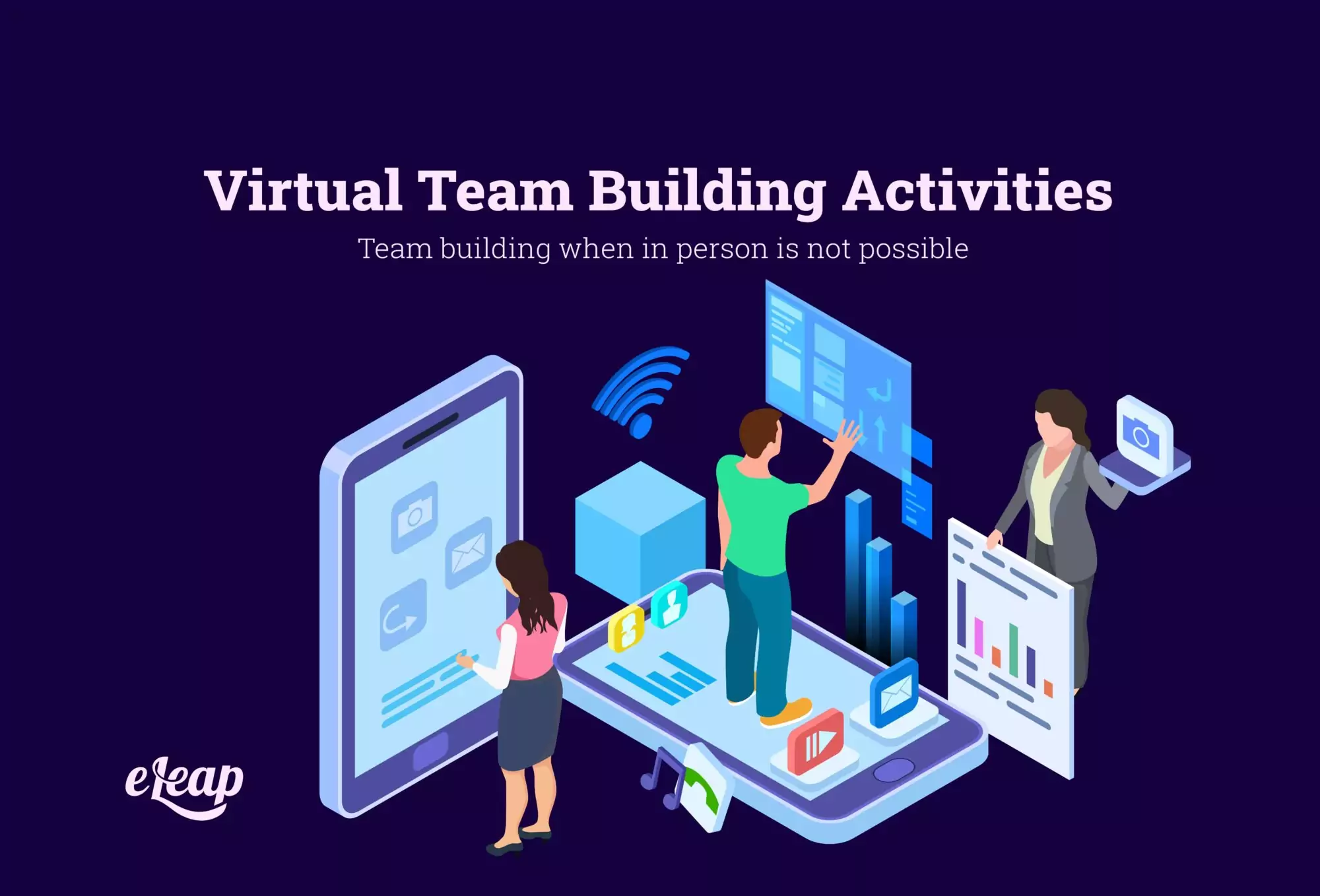Virtual Team Building Activities
Team building when in person is not possible

As more and more workplaces have moved to remote or virtual work, there is even more of a need for ways to have employees interact and engage with each other to build relationships, foster trust and respect, and make sure that everyone is on the same page with productivity and office motivation.

Virtual team building activities are a great way for a workplace community to come together online when they cannot do so in person to still develop relationships and build morale.
How to Bond as a Remote Team
Bonding as a workplace team over the Internet can be done by playing games, setting up group hangouts, or using icebreakers at the beginning or end of company-required meetings.
These become fun when rewards are attached, when members can chat with each other before or after the activity, and when employees need to work together to achieve a common goal.
Communication before, during, and after can help the team feel supported and encouraged. Make sure you give appropriate notice before a required or optional virtual team building activity will take place: give emojis, high-fives, or direct- or group-message comments throughout, and ask for feedback afterward from the group and individuals so you can plan for the next activity.
Any conflict or dispute should be handled quickly and appropriately as to not linger or become more difficult later on.
Ideas for Different Types of Virtual Team Building
There are myriad ways that an office or workplace manager can encourage team building virtually. Ice breakers, games, puzzles, and group tasks are all great ways to bring people together and encourage cohesion.
eLeaP has enough activities to keep you and your team entertained for a long time! Here are just some of the possible ideas.
Online/All-Together Virtual Team Building Activities
These activities are best used when people can gather online or over the phone all at once.
The Desert Island Problem
(Breakdown: Group video, 30 minutes, mid-level prep, team members need pre-shared lists, small-medium team size, high-level impact)
Before the activity begins, tell each team member that they are stranded on a desert island with a collection of only seven objects (you provide the lists). Individuals have to choose only three of these objects to use to survive on the island. Make the lists challenging with items that are not necessarily every day or island-survival items so that people have to use critical thinking skills to plan how they would survive.
This activity encourages critical and creative thinking and allows people the opportunity to present ideas in a non-threatening and low-pressure situation.
Whose Fact Is It? Guessing Game
(Breakdown: Group video, 30 minutes, mid-level prep, no supplies needed, small-medium team size, high-level impact)
Before the group comes together, collect the appropriate information from each employee. Then, compile everyone’s personal facts (think: hidden talents, obscure travels, second languages, uncommon favorite foods) into a shared document. Leave an empty space next to each fact, and the group must decide which facts belong to which team member.
This game encourages the team to work together, using prior knowledge to put the ‘puzzle’ together. It can result in some hilarity when the true answers are revealed!
Talk or Show and Tell
(Breakdown: Group video, 15-30 minutes, mid-level prep, team members may need items, small-medium team size, mid-level impact)
Each member of the group will get one minute to speak about something intangible that they are passionate about, or to ‘show and tell’ about a material object which is personal to them. This could be something as emotional as a great-grandparent’s heirloom, or something as silly as a favorite pair of cozy socks.
This activity helps humanize co-workers and establish emotional relationships.
Picture Sharing
(Breakdown: Group video, 10-20 minutes, mid-level prep, team members need photos, small-medium team size, mid-level impact)
During this activity, team members will simply share a photo that gives insight into their individual personality, family, hobbies, or life outside of work.
Sharing of personal memories helps team members see one another in a true light that they may not often get in the traditional workplace.
Life Bucket List
(Breakdown: Group video, 15-30 minutes, mid-level prep, team members need prepared lists, small-medium team size, mid-level impact)
Each member of the group will share a few items off of their bucket list (the list of things they would like to accomplish in life). Then the other members of the group could ask further questions, share their own experiences with another’s list item, or come up with more ideas for each other.
Sharing of personal life goals can help people find things that they have in common and remind a team that everyone has lives outside of work that affect who they are.
Storytime Creation
(Breakdown: Group phone call or video, 15-30 minutes, mid-level prep, no materials needed, small-medium team size, mid-level impact)
Gather the employees together on a virtual call (phone or video). Whoever begins (this is a great place for the manager to lead by example) will start an opening line of a story with a complete sentence and then add another that ‘hangs.’ The next person will complete the last sentence and then add on, ‘hanging’ their ending for the next person. When it comes back around to the first person, they end the story.
This game is a great, easy activity for when people need a tension-breaker or some quick laughter. People don’t mind being silly when it is an activity that will not have an effect on anything work related.
Conceptual Problems
(Breakdown: Group phone call or video, 15-30 minutes, mid-level prep, no materials needed, small-medium team size, mid-level impact)
The team leader or manager should give the team a pretend scenario that could theoretically happen to them in the workplace. The team members should develop and expand on problem-solving solutions or solutions.
This activity helps team members think critically and build on each other’s strengths.
Offline Virtual Team Building Activities
Not every workplace team can be together at the same time very often. For this reason, it is important to have opportunities in which people can participate on their own time and then come together on a platform to communicate at their leisure or see the group’s progress. Read on for a few ideas to achieve community-building and relationship this way.
Health/Fitness Challenge
(Breakdown: Any platform to track progress, team members will complete on their own and take 15-30 minutes for discussion/check-in, mid-level preparation, members might need access to exercise clothing/equipment, any team size, mid-level impact)
Encourage every member of the team to choose a health goal. For example, this could be following a healthy meal plan, participating in a certain number of exercise classes weekly, drinking more water, or reading a chapter of a self-help book each day.
At set times (weekly, bi-weekly, monthly) get together with the team to share progress and encouragement. When you know you are not alone in a goal, it can help make the process easier!
Team Book Club
(Breakdown: Phone/email/group messaging for discussion, team members will need to read on their own time and take 15-30 minutes for discussion/check-in, mid-level prep, all team members will need the same book, any team size, mid-level impact)
Choose a book (team members can even keep a list of ideas and a different person can select each month) and give the team a set date by which to complete it. Ask them to keep a journal of favorite quotes, ideas, and passages that they connect with. Choose a platform where team members can either write down their thoughts and comments and others can respond or choose a time when everyone can come together to discuss.
Bonding over something that is not directly related to workplace performance can help build relationships and trust in a safe, low-pressure way.
Daily Employee Journals/Prompts
(Breakdown: Any platform for discussion, individuals will journal on their own and take about 30 minutes for sharing, team members will need their own journals and list of prompts, mid-level prep, small-medium team size, mid-level impact)
Prepare daily journal prompts for a set time frame, say, one month. Encourage employees or team members to write in their journals daily according to their own comfort level (i.e., simply jotting down some brainstorming words, creating a poem, or detailing a relatable event). After the time period is completed, use a writing/commenting platform for team members to share what they have learned or discovered, or alternatively, come together to discuss all at once.
Journaling is a wonderful habit to use self-reflection and response to learn about the way your brain, emotions, and reactions work in relation to the world and others around you.
Benefits to Online or Offline Virtual Team Building Activities
Hopefully this list has begun spinning your wheels on how to build employee or team morale and bolster relationship-building among your group. Implementing these activities weekly or monthly on a regular basis will ensure that your group sees each other as individuals, bonds as a team, and works together for increased productivity and goal-setting for positive effects in the workplace. Feel free to be creative, expanding on these activities or coming up with new ones! The sky is the limit as long as people are bonding and working together.